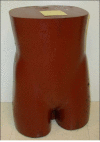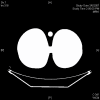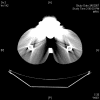Radiation dose reduction at a price: the effectiveness of a male gonadal shield during helical CT scans
- PMID: 17367529
- PMCID: PMC1831769
- DOI: 10.1186/1471-2342-7-5
Radiation dose reduction at a price: the effectiveness of a male gonadal shield during helical CT scans
Abstract
Background: It is estimated that 60 million computed tomography (CT) scans were performed during 2006, with approximately 11% of those performed on children age 0-15 years. Various types of gonadal shielding have been evaluated for reducing exposure to the gonads. The purpose of this study was to quantify the radiation dose reduction to the gonads and its effect on image quality when a wrap-around male pediatric gonad shield was used during CT scanning. This information is obtained to assist the attending radiologist in the decision to utilize such male gonadal shields in pediatric imaging practice.
Methods: The dose reduction to the gonads was measured for both direct radiation and for indirect scattered radiation from the abdomen. A 6 cm3 ion chamber (Model 10X5-6, Radcal Corporation, Monrovia, CA) was placed on a Humanoid real bone pelvic phantom at a position of the male gonads. When exposure measurements with shielding were made, a 1 mm lead wrap-around gonadal shield was placed around the ion chamber sensitive volume.
Results: The use of the shields reduced scatter dose to the gonads by a factor of about 2 with no appreciable loss of image quality. The shields reduced the direct beam dose by a factor of about 35 at the expense of extremely poor CT image quality due to severe streak artifacts.
Conclusion: Images in the direct exposure case are not useful due to these severe artifacts and the difficulties in positioning these shields on patients in the scatter exposure case may not be warranted by the small absolute reduction in scatter dose unless it is expected that the patient will be subjected to numerous future CT scans.
Figures





References
-
- Bahador B. Trends in Diagnostic Imaging to 2000. London , Financial Times, Pharmaceuticals and Healthcare Publishing; 1996.
-
- Evens RG, Mettler FA. National CT use and radiation exposure: United States 1983. Ajr. 1985;144:1077–1081. - PubMed
-
- Hayes J. Soaring CT use may prompt need for long-term dose monitoring. August. DiagnosticImagingcom. 2006.
MeSH terms
LinkOut - more resources
Full Text Sources

